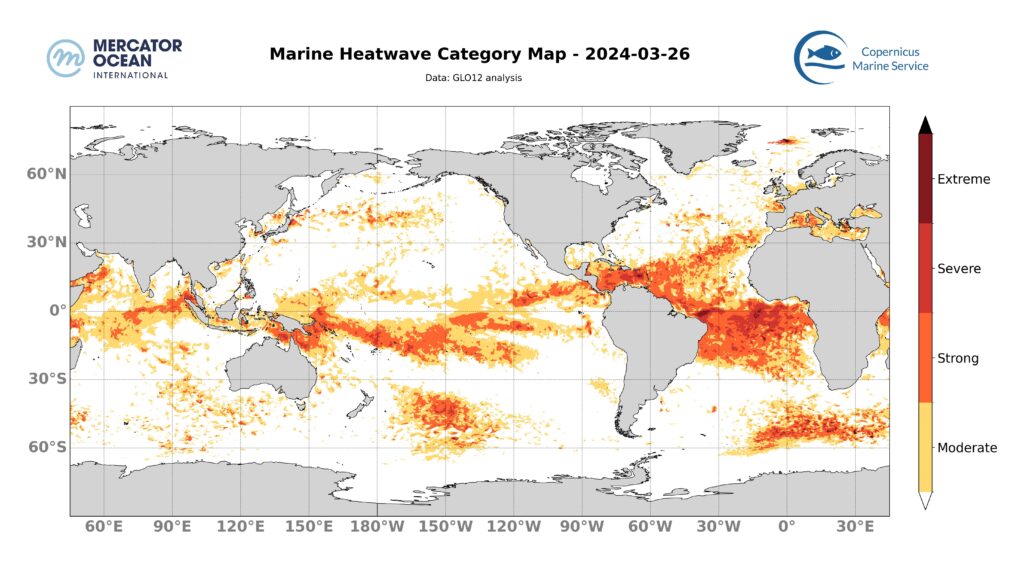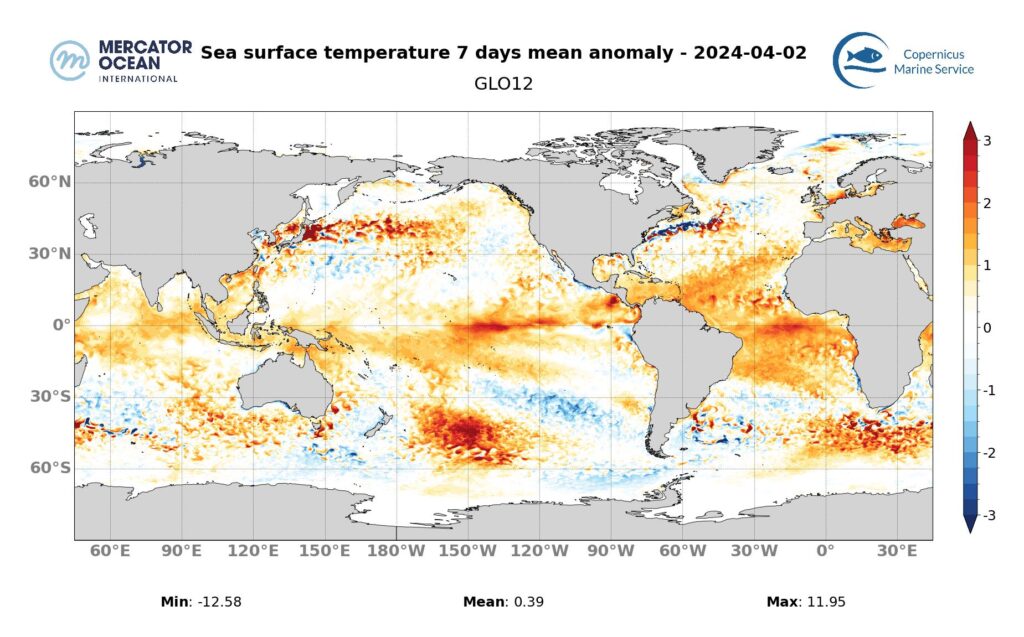Mercator Ocean International (MOi) oceanographers examine marine heatwaves across the global ocean. They analyse a variety of datasets from observations (satellite sea surface temperature maps) to numerical model analyses (assimilating satellite and in situ observations) and derive forecasts for a 7 day period.[1]
Assessment for March 26th
Marine heatwave categories

Atlantic Coast
The marine heatwave that has been present for several months along the Moroccan coast as far as the Bay of Biscay is easing, with a reduction in the extent of the strong and moderate categories.
Mediterranean Sea
In the western Mediterranean basin, the intensity of the marine heatwave is decreasing, with a reduction in the area covered by strong categories. In the eastern Mediterranean basin, the marine heatwave is easing off in the Adriatic and Ionian Seas, which are now mostly in the moderate category, while the rest of the area is stable, with moderate and strong categories for the most part.
North Tropical Atlantic Ocean
The extent of the marine heatwave remains stable. Its intensity is decreasing off Africa, with a shift from strong to moderate categories.
Caribbean Sea
The marine heatwave is intensifying, with an increase in the surface area of strong categories and the local development of severe categories.
Equator and South Tropical Atlantic Ocean
The extent of the marine heatwave remains stable. There is a decrease in the surface area of strong categories. Locally, off the northern coast of Brazil, the marine heatwave has been upgraded from severe to extreme.
Southern Ocean
Off South Africa (between 30°W and 30°E) – The marine heatwave intensifies, with moderate to severe categories east of 15°E.
Pacific Ocean
Tropical Pacific Ocean – The marine heatwave linked to El Niño conditions is intensifying, with an increase in the extent of strong categories. Moderate categories are also developing between Indonesia and Papua New Guinea, while strong categories are developing to the east and south.
South Pacific, east of New Zealand – The marine heatwave remains stable, with mainly moderate to severe categories.
Indian Ocean
In the Indian Ocean, the current marine heatwave may have intensified, with strong categories developing between northwest Indonesia and the Maldives.
Weekly temperature anomalies
Atlantic Coast – 0.5°C to 1.5°C
Mediterranean Sea – 0.5°C to 1.5°C
North Tropical Atlantic Ocean – 1°C to 1.5°C
Caribbean Sea – 1°C to 1.5°C
Off the Equator and South Tropical Atlantic Ocean – 1°C to 1.5°C
Southern Ocean – 1°C to 3°C
Tropical Pacific Ocean – 0.5°C to 1°C (up to 3°C east of the basin)
South Pacific Ocean – 1 °C to 2.5°C
Indian Ocean – 0.5°C to 1°C
Forecast for April 2nd

Zone Europe
North Atlantic Ocean – For April 2nd, the Mercator Ocean International (MOi) forecasting system predicts that the marine heatwave will diminish in surface area along the North-East Atlantic seaboard, with only moderate to locally strong categories remaining.
Mediterranean Sea – In the western Mediterranean basin, marine heatwave intensity will decrease from moderate and strong to mostly moderate.
In the eastern Mediterranean basin, the marine heatwave will intensify, rising from moderate to mostly strong and locally severe.
Global Ocean
North Tropical Atlantic – MOi forecasts that the marine heatwave present in the North Tropical Atlantic will increase in intensity, with the transition from moderate to strong categories, as well as the development of severe categories locally.
Caribbean Sea – The intensity of the marine heatwave will diminish with the reduction in the extent of the strong categories.
Equator – The marine heatwave will remain stable overall.
South Tropical Atlantic – The surface area of the marine heatwave will remain stable overall.
Southern Ocean – To the south-west of South Africa (between 30°W and 30°E), the marine heatwave will remain generally stable.
Tropical Pacific Ocean – The marine heatwave linked to El Niño conditions will strengthen in the center of the basin, with an increase in the surface area of strong categories and the development of severe categories.
Southeast Asian Seas – The marine heatwave around Papua New Guinea will diminish in intensity to the south, with the transition from strong to moderate categories, while strong categories will develop to the south of the South China Sea, between Malaysia, Indonesia and Vietnam.
South Tropical Pacific – The marine heatwave east of New Zealand in the South Pacific will intensify, with a larger surface area in the strong category.
Indian Ocean – The extent of the marine heatwave to the north of the basin is increasing. Its intensity is increasing, with strong categories more widespread to the south of India and Sri Lanka.
What are marine heatwaves?
Marine heatwaves (MHW) are extreme rises in ocean temperature for an extended period of time. They can occur at different locations in the ocean, and their magnitude and frequency have increased over the last couple of decades, with harmful impacts on ecosystems, and human activities. According to the latest report released by the Intergovernmental Panel on Climate Change (IPCC AR6 SYR), it is found with high confidence that in the near-term at 1.5°C global warming, the increasing frequency of marine heatwaves will increase risks of biodiversity loss in the oceans, including from mass mortality events.[2]
How are marine heatwaves calculated?
A marine heatwave is a heat episode during which the temperature is significantly higher than a certain threshold for at least 5 consecutive days.

Figure adapted from Hobday et al. (2018)
The seasonally-varying threshold is defined on a daily basis according to a sufficiently long climatic period (in this case 1993-2016). So, for a given place and a given day, knowing all the surface temperatures observed over the last 30 years, a heatwave situation is defined as one where the temperature measured is within 10% of the maximum values observed (i.e. above the 90th quantile, see diagram), for at least 5 consecutive days.
The main characteristics of heatwaves are their duration and intensity. The intensity for a given day corresponds to the value in degrees above the 90th quantile (blue arrow), which can either be calculated as the cumulative intensity throughout the heatwave event, or the maximum intensity.
Heatwaves are categorised on the basis of their deviation from the mean temperature or anomaly (green arrow): a deviation of more than 2 times the difference between the 90th quantile and the mean corresponds to a heatwave in the strong category; a deviation of more than 3 times corresponds to a heatwave in the severe category; and a deviation of more than 4 times corresponds to a heatwave in the extreme category.
[1] Analysis of datasets: SST OSTIA (Copernicus Marine Service), OISST (NOAA), GLO12 (Copernicus Marine Service / Mercator Ocean International), PSY4 (Copernicus Marine Service / Mercator Ocean International), and GLO12 et PSY4 forecasts.
[2] IPCC AR6 SYR chapter 4.3 https://www.ipcc.ch/report/ar6/syr/downloads/report/IPCC_AR6_SYR_LongerReport.pdf
